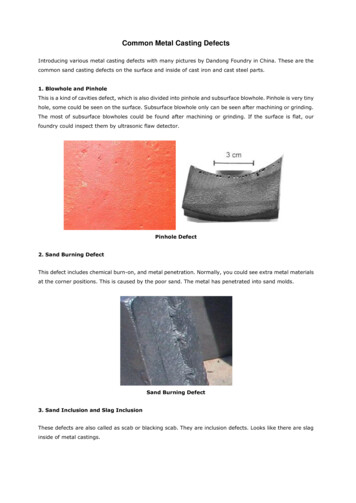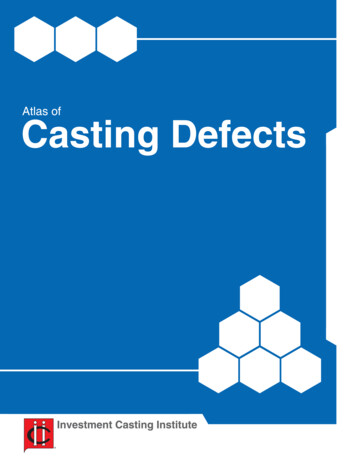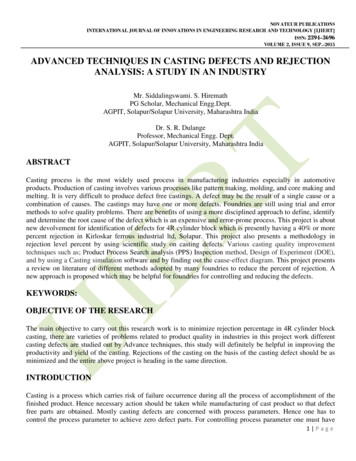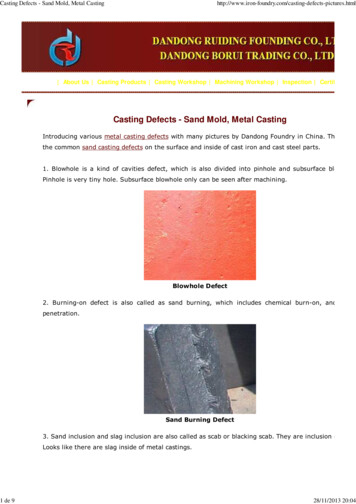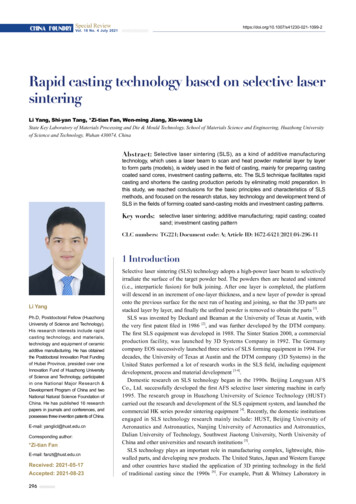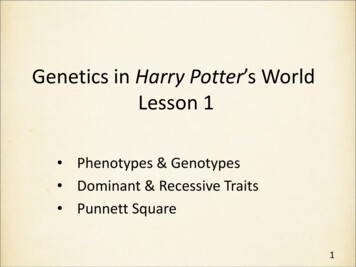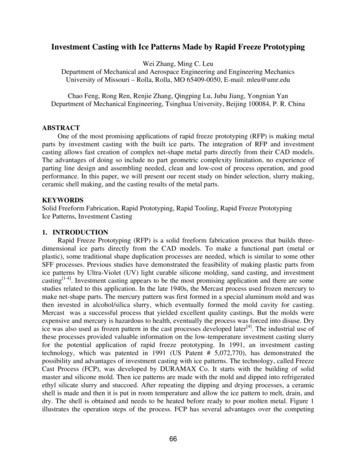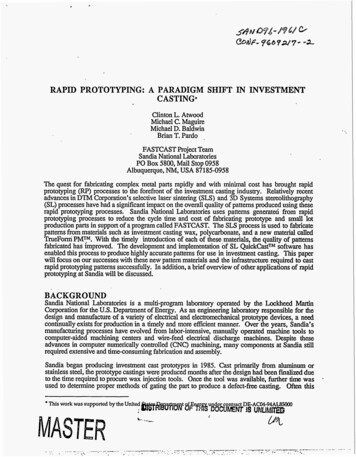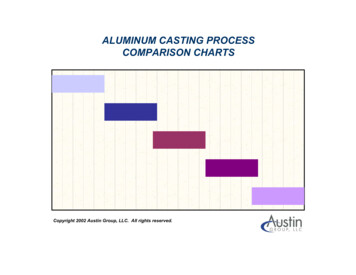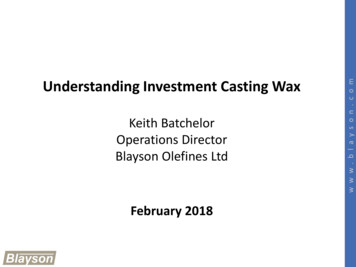
Transcription
Keith BatchelorOperations DirectorBlayson Olefines LtdFebruary 2018w w w . b l a y s o n . c o mUnderstanding Investment Casting Wax
Brief History Beeswax was utilized in the lost wax process by craftsmen inthe ancient civilizations of China & Egypt Today the name wax applies to any substance having wax likepropertiesw w w . b l a y s o n . c o m Wax is the oldest thermoplastic material known to man
In order to make patterns for early moulds many types ofmaterials were used These materials included beeswax, tallow, resin, tar Though suitable for castings at the time, these would beunsuitable for the demands of modern manufacturew w w . b l a y s o n . c o mBrief History
The demands of modern manufacture require complexcompounds for today's industry Modern wax is made up of materials such as Paraffin wax Microcrystalline wax Hard wax Resins Polymers Fillersw w w . b l a y s o n . c o mModern Materials
Structure of Investment Casting Wax Key properties such as melting point, hardness, viscosity,expansion and contraction, setting rate are all influenced bythe structure and composition of the wax compound The complex composition manifests itself in a physicalbehaviour different to that of other substances Knowledge of the properties of the individual components andhow they interact is essential in understanding the behaviourof wax during the investment casting processw w w . b l a y s o n . c o m Many variations are formulated to suit differing requirements
Unlike other homogeneous chemical compounds wax does notmelt immediately on heating but passes through severalintermediate states The cycle is reversed in the cooling uidsemi-plasticsemi-liquidw w w . b l a y s o n . c o mPhase Changes
Expansion & Contraction Like other materials wax expands on heating and contracts oncooling In comparison with a metal the expansion is relatively high Wax expansion and contraction rates are not uniform but varywith phase and structure changes during heating and coolingw w w . b l a y s o n . c o m The structure and components used in an investment castingwax will influence the expansion and contraction
Wax Temperature Control Any temperature changes take hours to achieve As a general rule 15 minutes per degree Celsius issuggested When using automatic wax filling it is important that theliquid level in the holding tank does not fall too low Temperature gauges give an indicative reading only andoften do not reflect the wax temperature in the centre ofthe tank Die temperature will change with use, this may give riseto changes in wax injection characteristicsw w w . b l a y s o n . c o m Wax has a very poor thermal conductivity
Fluidity is the ability of a material to flow, in particularthrough thin sections The effects of wax fluidity should not be underestimated Too low a fluidity may cause non-fill or flow lines Too high a fluidity will lead to turbulence during injectioncausing flow lines and air entrapmentw w w . b l a y s o n . c o mWax Fluidity
040178Bƒ f (T)l0049ƒ f (T) There is a clear relationshipbetween the viscosity of a waxand its fluidity, the moreviscous, generally the lessfluid, e.g. water and treacle111098ƒ [Pas]7654321060ThermoHaake RheoWin Pro 2.92657075T [ C]8085 There is a relationshipbetween temperature andfluidity, the cooler the wax anddie temperatures the lowerthe fluidity Experiments show a linearrelationship occurs in theliquid and paste regions, butnot around the congealingpointw w w . b l a y s o n . c o mWax Fluidity
Factors Affecting Fluidity At Injection Die temperature Die thermal conductivity Section thickness andchanges in sectionInteraction Plot (data means) for Flow lines-11-1143Flow-11Flow243Pressure-11P r essur e2 Injection pressure and flowT emper atur e108 100107106L0866 (RECON RT) Oscƒ' f (T)Ì f (T)L0878 (RUNNERTECH) Oscƒ' f (T)Ì f (T)L0657A (R A PREC03) OSCƒ' f (T)Ì f (T)80105ƒ' [Pas]Ì [ ]60104 The ability of the die toevacuate the air (airresistance)310401021012010010-1404550556065T [ C]ThermoHaake RheoWin Pro 2.9270758085 Finish of the die and releaseagent (surface tension) Set rate of the waxw w w . b l a y s o n . c o m Wax temperature
Whether its inside or outside wax materialswill age prematurely with sunlight – Ifstored outside ensure they are covered, ifinside ensure they are not located directlybelow a sky light What are the effects of temperature? Wax pellets stored in cold conditions, forexample just above freezing should not beaffected unduly as long as in sealed bags Remember wax takes a long time to rewarm Pellets stored at elevated temperatures forexample above 30 C may soften and sticktogetherw w w . b l a y s o n . c o mAdvice on Wax Storage
Advice on Wax Storage If too cold then the wax may embrittle particularly as itcontracts around inserts such as cores and crack This applies in areas such as wash off tanks where the waterincluding fresh water must be held around 18 - 22 C Other areas of concern might be weld joints which may openup as a results of variation in contraction of components In elevated areas, particularly in roof storage for example inuncontrolled shell areas, waxes may soften and distort Ideal storage temperatures 20 - 22 Cw w w . b l a y s o n . c o m Injected patterns are a very different story !!
Care should be taken to ensure that waxproducts are not in direct contact withsolvents for long periods as this will“soften” or even dissolve them Wax materials have a shelf life, typically2 years if storage conditions are ideal With materials such as water solublewax it is important to ensure they aresealed from moisture in the atmosphere If in doubt get your supplier to retestthe product and confirm its suitabilityw w w . b l a y s o n . c o mAdvice on Wax Storage
Wax testing has traditionally beenbased around the Petrochemicalindustry with tests such as– Congealing point– Melting point– Viscosity– Penetration– Percentage ashC.P. Although a place remains for suchtests complexity of design andperformance demands requires achange in thinkingw w w . b l a y s o n . c o mTraditional Wax Testing
Advanced Wax Testing Rheometry Infrared analysis (FTIR) Differential scanning calorimetry (DSC) Thermomechanical Analysis (TMA) Wax Strength Analysis Injection profiling and fluidity analysisw w w . b l a y s o n . c o m Test methods specifically developed to model how the wax isused in the foundry
w w w . b l a y s o n . c o mTips to MinimiseWax Related Defects
Definition - a negative surface indication seen as a linefrom above Cause - lack of energy within the wax either as a result ofcold wax or turbulence Problem - can be a source of ceramic inclusions onshelling, weakening of the wax structure Possible solutions–––––Increase the injection pressureIncrease the temperatureReduce the turbulence by reducing pressure and or flowUse a filled waxUse more viscous waxw w w . b l a y s o n . c o mFlow Lines
Definition - a rough surface finish which visually has a“sandpaper” effect Cause - lack of wax fluidity Problem - can be a cause of ceramic inclusions on shelling Possible solutions– Increase wax fluidity by means of increasing thetemperature– Use a more fluid waxw w w . b l a y s o n . c o mSurface Pitting
Definition - a surface depression, normally in the form ofa bowl like shape Cause - lack of feed to the area in question Problem - a cause of dimensional problems Possible solutions– Reduce the injection temperature– Increase the size of the injection sprue– Use a filled wax– Use a wax “chill”– Reduce die temperaturew w w . b l a y s o n . c o mCavitation
Definition - final wax dimensions are outside of therequired specification Cause - wax contraction is incorrect Problem - the finished parts are to the wrong size Possible solutions– Change wax temperature– Change wax– Change die dimensions (expensive)w w w . b l a y s o n . c o mIncorrect Wax Dimensions
Definition - either surface or just below surfacedepressions caused by air Cause - the air is unable to escape from the wax quicklyenough during injection Problems - a possible source of ceramic inclusions onshelling Possible solutions– Reduce wax turbulence– Increase wax viscosity– Allow air to escape from the die more easilyw w w . b l a y s o n . c o mAir Defects
Definition - the cavity either does not fill completely orthe pattern has rounded edges Cause - insufficient wax energy to fill the die cavity Problem - incorrect dimensions Possible solutions– Increase injection pressure– Increase wax temperature– Make wax more fluid– Improve wax venting– Reduce turbulencew w w . b l a y s o n . c o mNon Fill or Cold Shut
Ensure any negative depressions such as flowlines and surface depressions are filled in orpolished out Parts should be allowed to complete contractionbefore assembly as failure to do this may putpressure on the joints Remember wax has a ‘memory’, and particularlytwisted sections will attempt to straightenthemselves over time once taken off setters Any liquid runs from glue or welding should betrimmed off, as they can be a source of shellinclusions Air Defects near to or breaking the surface mustbe exposed and filled Ensure all surfaces are clean and free fromrelease agent, consider use of pattern wash Consider automationw w w . b l a y s o n . c o mGood Assembly Practices
Summary They consist of many different components Consequently they exhibit a range of properties Wax properties influence pattern behaviour in thefoundry and ultimately the quality of castings produced The understanding of wax characteristics and their controlis critical to the investment casting foundryw w w . b l a y s o n . c o m Investment casting wax compounds are complex
w w w . b l a y s o n . c o mThank You
Structure of Investment Casting Wax Many variations are formulated to suit differing requirements Key properties such as melting point, hardness, viscosity, expansion and contraction, setting rate are all influenced by the structure and composition of the wax compound The complex composition manifests itself in a physical
